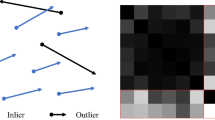Abstract
In this article, we study the multiplicity of solutions of the motion problem. Given n point matches between two frames, how many solutions are there to the motion problem ? we show that the maximum number of solutions is 10 when five point matches are available. This settles a question which has been around in the Computer Vision community for a while. We present two approaches:
-
the first one is based on algebraic geometry has been developed by Demazure [Dem88]. We show that it provides a very simple answer to the multiplicity of solutions when more than 5 point matches are available, namely not more than 3.
-
the second one is based on projective geometry and is based on the work of Kruppa [Kru13]. We correct Kruppa's result and show that it is compatible with Demazure's.
We then describe a computer implementation of the second approach that uses MAPLE, a language for symbolic computation. The program allows us to exactly compute the solutions for any configurations of 5 points. Some preliminary experiments are described.
Preview
Unable to display preview. Download preview PDF.
Similar content being viewed by others
References
M. Chasles. Question No. 296. Nouv. Ann. Math., 14:50, 1855.
M. Demazure. Sur deux problèmes de reconstruction. Technical Report, INRIA, 1988. To appear.
O.D. Faugeras and M. Hebert. The Representation, Recognition, and Locating of 3D Shapes from Range Data. The International Journal of Robotics Research, 5(3):27–52, 1986.
O.D. Faugeras and S.J. Maybank. Multiplicity of solutions for motion problems. Technical Report, INRIA, 1988. To appear.
O. Hesse. Die cubische Gleichung, von welcher die Lösung des Problems der Homographie von M. Chasles abhängt. J. reine angew. Math., 62:188–192, 1863.
B.K.P. Horn. Closed-form Solution of Absolute Orientation using Unit Quaternions. Journal of the Optical Society A, 4(4):629–642, April 1987.
B.K.P. Horn. Relative orientation. A.I. Memo 994, MIT, October 1987.
E. Kruppa. Zur Ermittlung eines Objektes aus zwei Perspektiven mit innerer Orientierung. Sitz.-Ber. Akad. Wiss., Wien, math. naturw. Kl., Abt. IIa., 122:1939–1948, 1913.
H.C. Longuet-Higgins. Mental Processes: Studies in Cognitive Science, chapter Configurations that defeat the eight-point algorithm, pages 395–397. MIT Press, Cambridge, MA-London, 1987.
H.C. Longuet-Higgins. Multiple interpretations of a pair of images of a surface. Proc. Roy. Soc. Lond. A., 1988.
S.J. Maybank. The angular velocity asociated with the optical flow field due to a rigid moving body. Proc. Roy. Soc. Lond. A, 401:317–326, 1985.
S.J. Maybank. A theoretical study of optical flow. PhD thesis, University of London, Birkbeck College, November 1987.
J.G. Semple and G.T. Kneebone. Algebraic Projective Geometry. Oxford: Clarendon Press, 1952. Reprinted 1979.
R. Sturm. Das Problem der Projektivitat und seine Anwendung auf die Flächen zweiten Grades. Math. Ann., 1:533–574, 1869.
Author information
Authors and Affiliations
Editor information
Rights and permissions
Copyright information
© 1989 Springer-Verlag Berlin Heidelberg
About this paper
Cite this paper
Faugeras, O.D., Maybank, S. (1989). Motion from point matches: multiplicity of solutions. In: Boissonnat, J.D., Laumond, J.P. (eds) Geometry and Robotics. GeoRob 1988. Lecture Notes in Computer Science, vol 391. Springer, Berlin, Heidelberg. https://doi.org/10.1007/3-540-51683-2_30
Download citation
DOI: https://doi.org/10.1007/3-540-51683-2_30
Published:
Publisher Name: Springer, Berlin, Heidelberg
Print ISBN: 978-3-540-51683-5
Online ISBN: 978-3-540-46748-9
eBook Packages: Springer Book Archive




